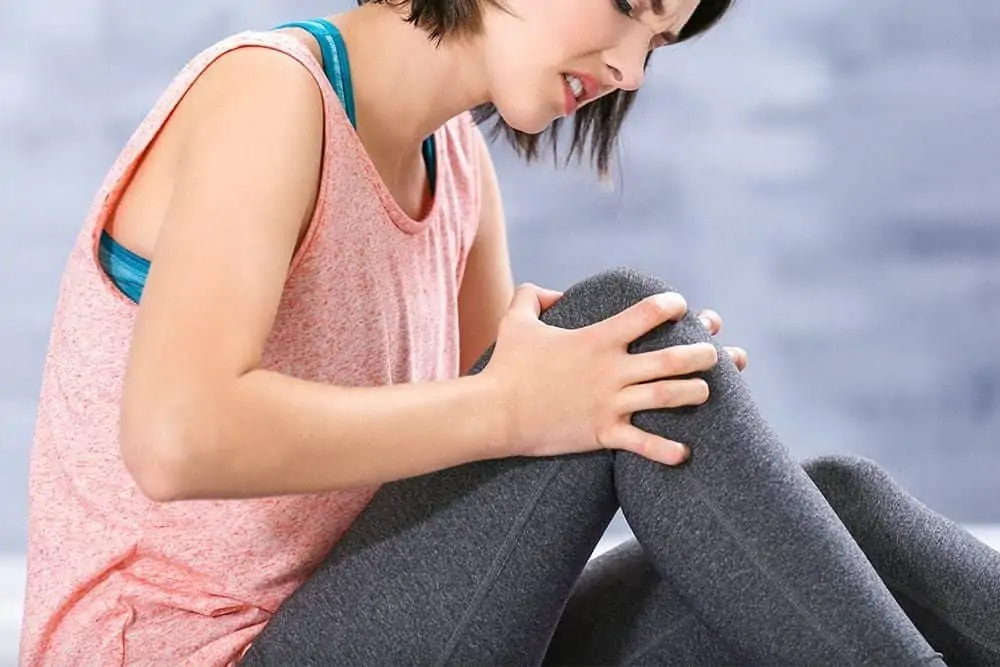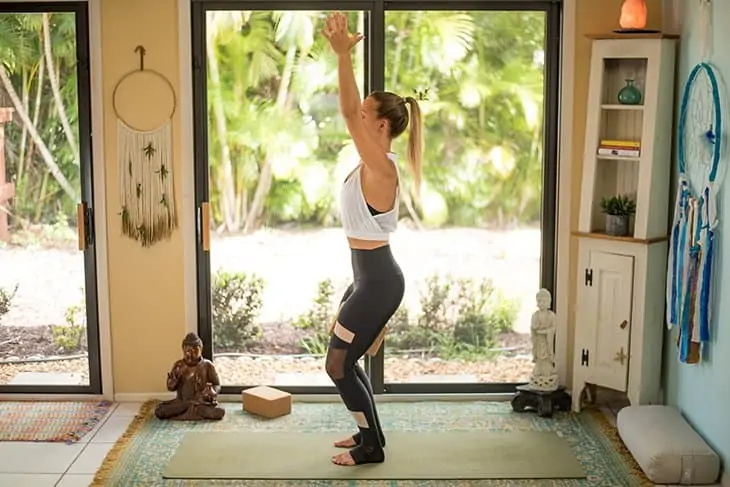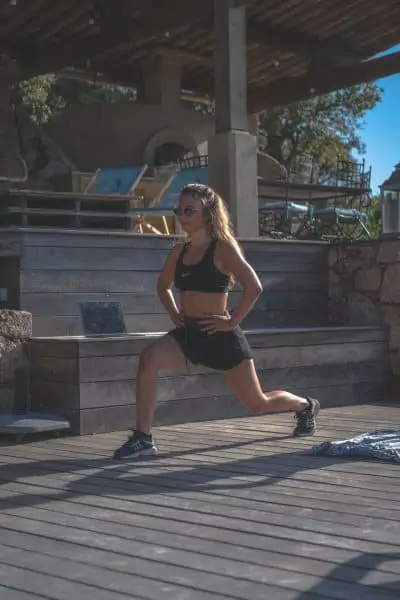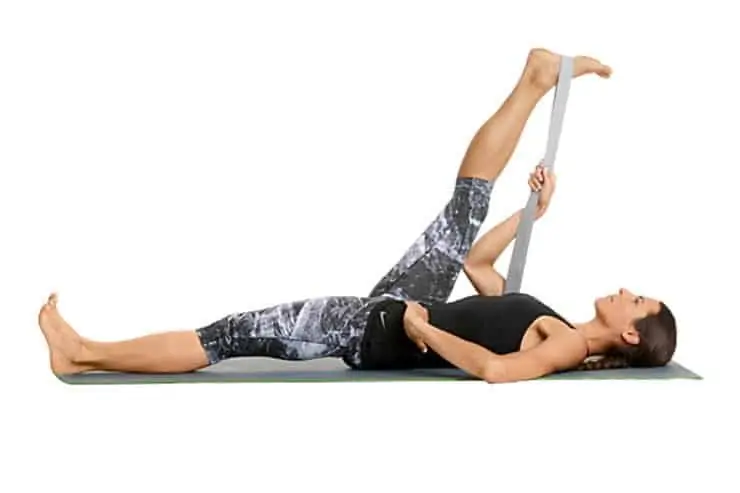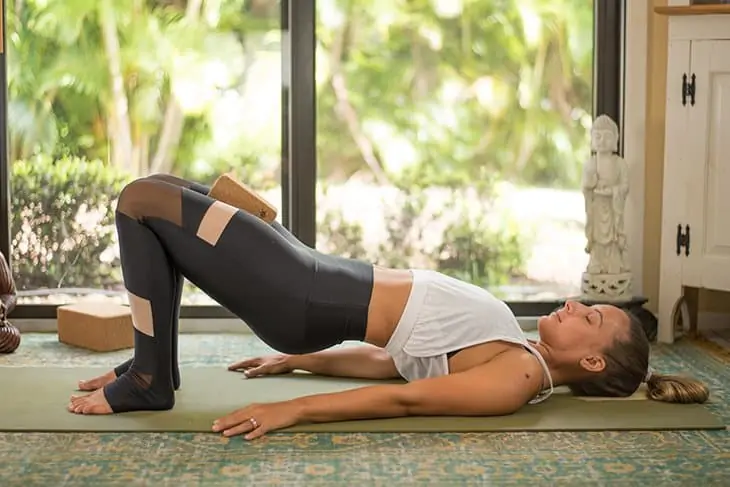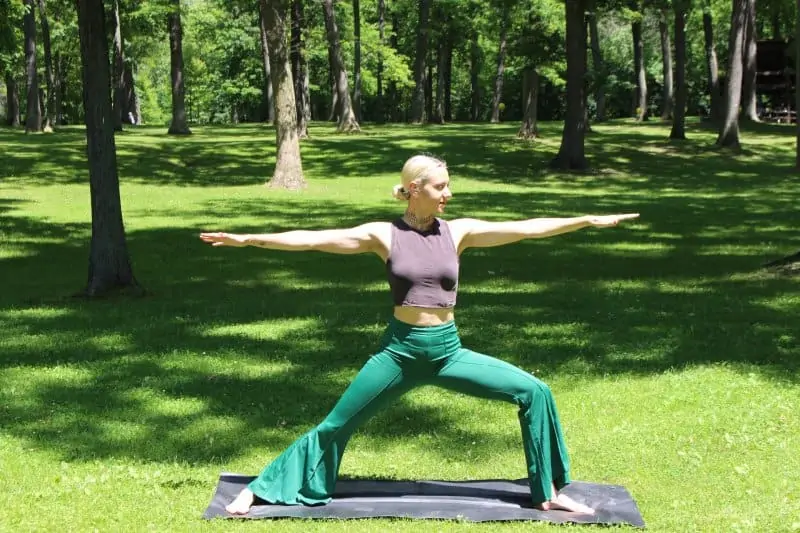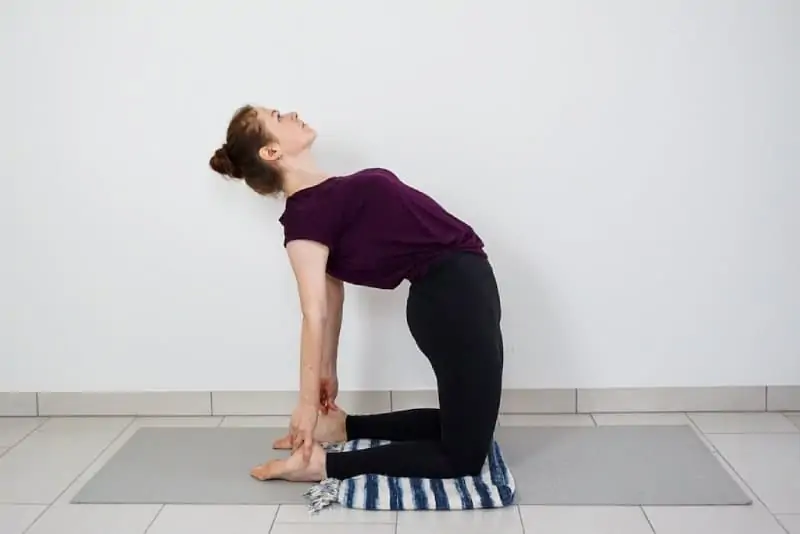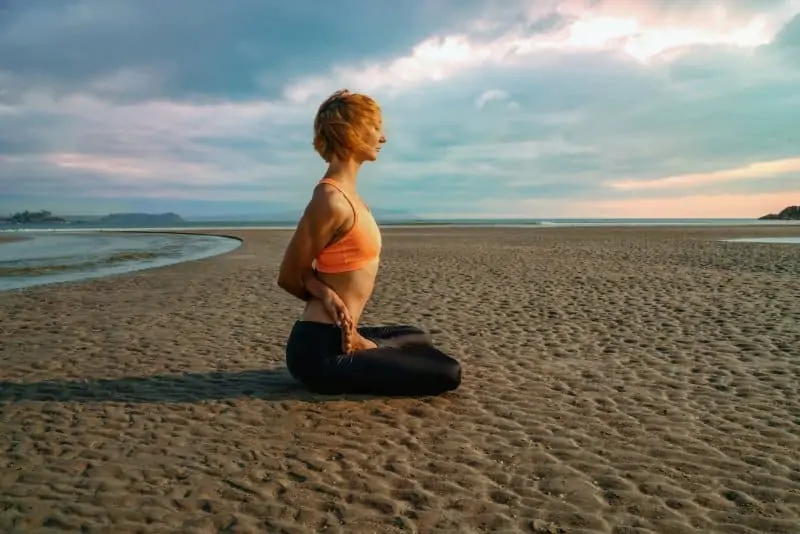Key Takeaway
Regular yoga practice, with proper modifications and the use of props, can strengthen the muscles around the knee, improve joint mobility, and alleviate chronic knee pain.
There is nothing worse than getting up and feeling a sudden jolt of pain in your knees. Our joints are the crux of our mobility, yet an estimated 25% of Americans have some form of chronic knee pain.
Americans get over 600,000 knee replacements every year. If that isn’t a sign that something needs to change, then I don’t know what is! Could it be that yoga is a solution to reduce chronic knee pain?
Can yoga actually strengthen the knee joint and alleviate knee pain? Can yoga help to keep our knees healthy so that we don’t become part of those statistics?
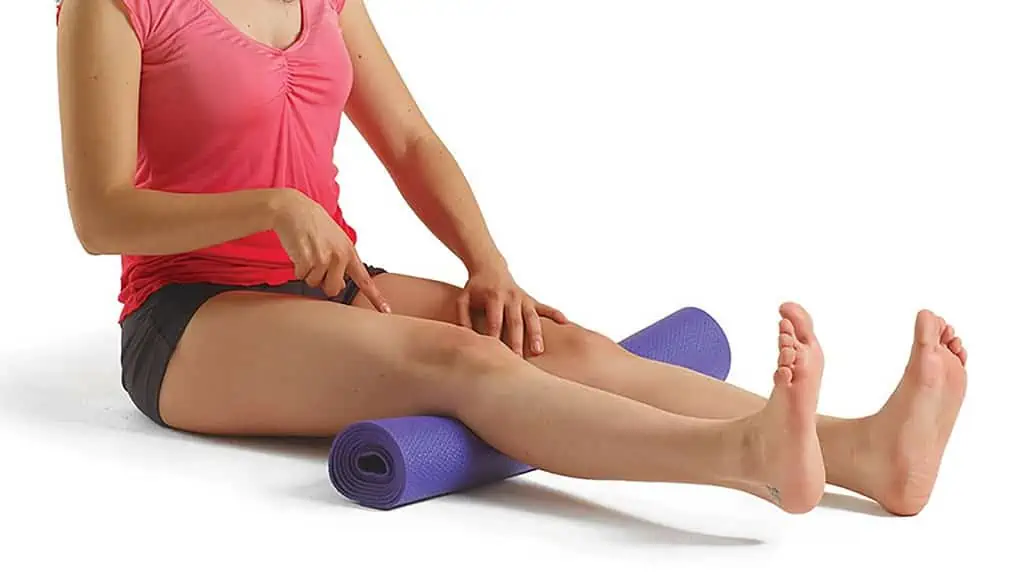
Can yoga actually help with knee pain? Can yoga help keep our knees healthy so we don’t become part of those statistics?
The research says yes! Let’s explore joint health and yoga to see if regular practice can really help alleviate those achy knees.
Contents
Common Causes of Knee Pain
While it may seem to be a targeted area, knee pain is more complicated than it seems. Bodily factors like age and obesity are associated with a greater risk for knee pain.
There are also many health conditions that can cause knee pain, including:
- Osteoarthritis (degeneration of joints)
- Rheumatoid arthritis (chronic autoimmune inflammation that causes swelling)
- Gout (uric acid build up causes arthritis )
- Dislocated kneecap
- Meniscus tear (damage to cartilage around the knee)
- Torn ligament (commonly the ACL)
- Bursitis (inflammation from knee injury)
These conditions definitely can’t be cured by yoga, but research has shown that yoga can definitely help reduce pain. One study found that yoga can even be as effective as the more expensive massage therapy route.
If you are dealing with one of these painful knee conditions, it is recommended that you see a physical therapist or medical professional for support and assistance in your knee pain recovery journey.
A physical therapist will be able to help you determine certain yoga poses that should be avoided and some yoga poses that will help with the knee pain.
Also, ensure that you inform your certified yoga teacher about your injury before your yoga class!
Benefits of Yoga for Knee Pain
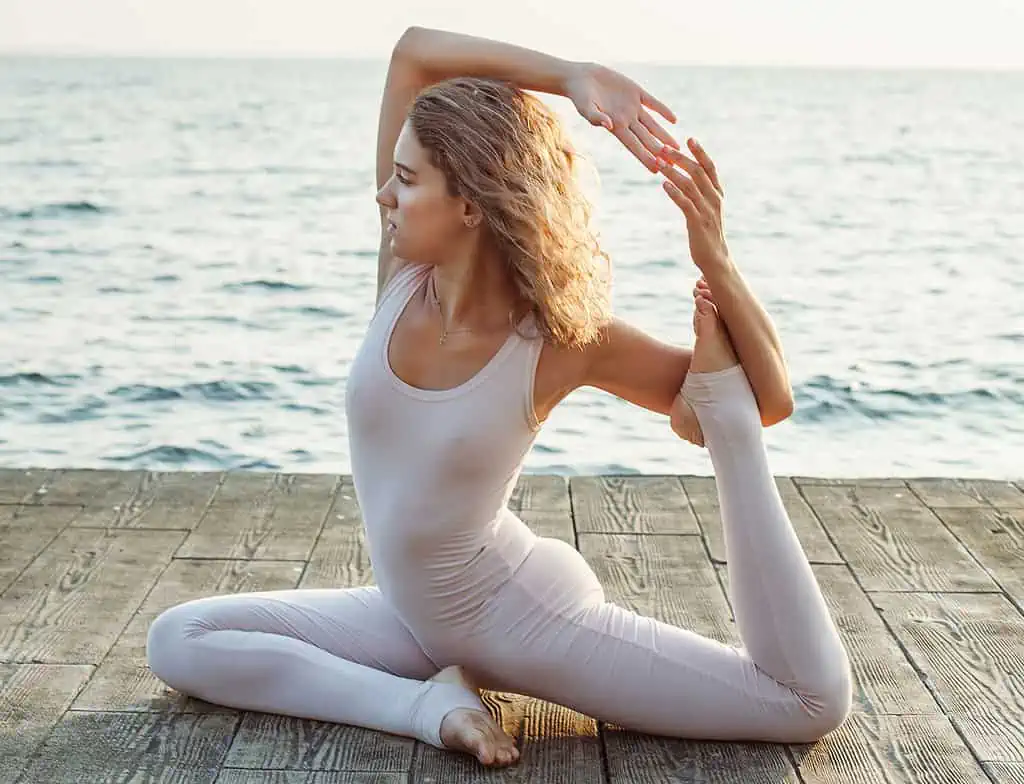
Things like bad posture, poor form when exercising, low muscle tone, improper stretching, and a sedentary lifestyle are all factors that can make knee pain much worse.
Yoga for knee pain can directly address these issues and help to relieve ongoing knee pain by strengthening certain muscles and providing adjustments with yoga props to support your body on the road to recovery.
Yoga is a tool for improving your joint mobility, flexibility, and overall leg strength. Remember that knees don’t exist in isolation; therefore, knee pain is usually a much larger issue surrounding that area of the body.
To Reduce Pain, Strengthen Around the Knee
Like many health issues, the problem isn’t just the symptom. Sure, our knees hurt, but that doesn’t necessarily mean that the pain is coming directly from the joint itself. Our knees are part of an integrated system of muscles, ligaments, and cartilage.
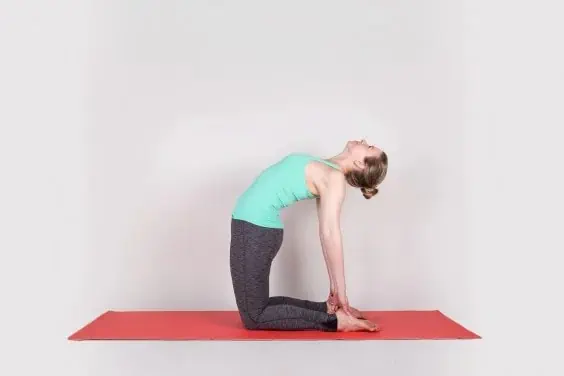
Knees include four major muscle groups:
- Hamstrings (knee extensors)
- Quadriceps (knee flexors)
- Hip adductors (the inner thighs)
- Hip abductors (the outer thighs)
It is important to build up those muscles in and around the knee so they can support the joint and reduce the risk of injury. Research shows that yoga strengthening poses focused on the knee extensors and flexors significantly improve knee pain and mobility. Let’s explore a couple of strengthening exercises that have been clinically shown to improve knee conditions like osteoarthritis.
Best Props for Knee Pain
Before you get started with yoga poses to help with knee pain, you’ll definitely want to invest in some props so that you don’t accidentally make the pain any worse.
The truth is that many traditional yoga poses can put a lot of pressure on those with injured knees, arthritis, or other joint issues. However, yoga should never feel painful. The best props for yoga with knee pain are:
These props can be used during your yoga practice to give extra support on top of your yoga mat. For example, a blanket can be folded and placed on top of a yoga mat to provide an extra layer of cushioning in a kneeling position.
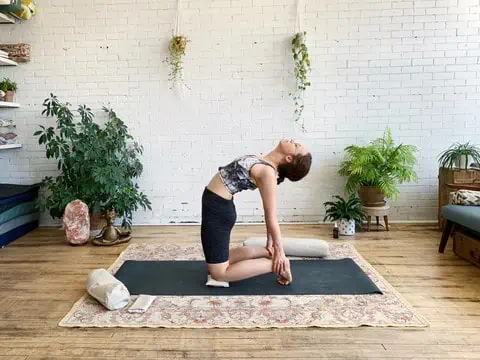
Two yoga blocks can help prevent injury by supporting your body weight with your hands instead of fully resting your body weight in the legs or knees.
A yoga bolster can help by supporting muscles around the knees and keeping the knees bent in reclined positions. This is important for anyone who needs knee pain relief during savasana or similar poses.
Any time you feel pain, you should stop and gently back out of the pose. Using one or several of these props can help you modify certain asanas so you can still enjoy a good stretch without so much tension on your knees.
Best Yoga Poses for Knee Pain Relief
Relieving knee pain is a long-term game. It won’t go away overnight, nor will yoga magically fix years of knee abuse. That’s right—you can abuse your knees with a sedentary lifestyle, running on concrete, neglecting your leg muscle building, or lack of flexibility. These yoga poses help you start awakening the knee-support system we talked about above.
Chair Pose (Utkatasana)
Scientific studies have shown that chair pose is one of the most effective ways to strengthen the knees and reduce knee pain. However, alignment is everything in this simple, strengthening pose. Be sure to keep your knees stacked over your shins and the weight back in the heels. This will activate and work your hamstrings and glutes.
Here’s how to ease into a chair pose without hurting your knees:
- Start with feet hip-width apart
- To help with alignment, place your yoga block between the upper thighs (or simply activate your thighs if you aren’t using a block prop)
- Flex your inner thighs, hamstrings, and quads
- On an exhale, slowly sit your glutes back, bending the knees but never allowing them to move forward past the ankles (use a mirror to check alignment)
- Squeeze the block throughout
- Hold for 3–5 full breaths
Note: A lot of yoga teachers will cue this pose, asking you to keep your big toes and knees together. If you are struggling with knee pain, definitely try to keep your feet and knees hip-width apart.
This will activate the inner thigh muscle and may even produce a deeper stretch. Make sure you have your toes pointing straight ahead, and shift the weight into the back of your feet. You may even be able to lift a big toe off the ground! This will activate through the inner arch and inner heel of your foot, stabilizing the knee joint.
High Lunge (Utthita Ashwa Sanchalanasana)
Knee caps easily get rolled around in our daily lives. If you’re unlucky, they can even dislocate. The key to keeping kneecaps where they’re supposed to be is strengthening the quads. The high lunge pose is targeted strength-building for your inner quad muscles (vastus medialis) to keep knee caps aligned.
How to do high lunge to prevent knee pain:
- Fold a yoga blanket and place it under your knees
- Come up onto your hands and knees on the tabletop (optional: place your hands on two yoga blocks shoulder-width apart if you are still building flexibility)
- Make sure the knees are square beneath the hips and hands are aligned beneath the shoulders
- Step your right foot forward between your two hands (or blocks)
- The knee should be directly over your ankle
- Tuck the back toes under and straighten the leg
- Push the back heel toward the floor and keep the front leg at a right angle
- Optional: flex your core and release your hands to stand up in a full lunge, arms toward the sky
- Slowly release by lowering the back knee and returning to the tabletop
Note: Be super careful of the knee joint here. This yoga pose will build strength in the leg muscles over time by practicing yoga often, but in the beginning, you might still find that your knee joints feel unstable.
If this is the case, do this pose near a wall, chair, or somewhere that you have something to hold onto? You want to help relieve knee pain by ensuring the bent leg at the front is at a 90-degree angle, and the back leg slowly works toward a straight position (while still keeping a small micro bend in that back knee).
Be sure to engage your upper body here too. The surrounding muscles of the knee will be more stable when your core is stable too!
Assisted Supine Hand-to-Big-Toe Pose (Supta Padangusthasana)
Tight hamstrings may not seem related to knee pain, but hamstring stretches significantly improve knee health. Studies have found that reduced hamstring strength and flexibility increase the risk of a knee injury, specifically ACL ruptures (ouch!)
This reclined hamstring stretch uses a yoga strap to prevent any rotation or hip movement. It also just feels so good.
How to use a yoga strap in a reclined hamstring stretch:
- Lay down flat on your back, with your yoga strap within reach.
- Allow your spine to feel long and naturally curved.
- Ground your left leg into the floor and flex your left foot and toes up toward the ceiling.
- Gently bend your right knee, pull the right leg into your chest, and place the yoga strap around the ball of the right foot.
- Begin to slowly extend your right foot up toward the sky, holding the strap in your right arm.
- The left arm can rest on top of the left hip flexor to keep it grounded on the floor.
- Feel the length in the back of your hamstrings as you work to get your legs straight.
- Gently release the right side, and feel the blood flow back into the right foot.
- Rest for a moment to notice the difference between the left and right legs. Then, when you are ready, swap sides.
This pose is not only great for releasing tension in the hamstrings and muscles surrounding the knees, but it will also help to get into any tight hips and hip adductors, allowing for proper functioning of the entire lower body!
Assisted Bridge Pose (Setu Bandhasana)
A simple bridge pose works wonders for soothing and strengthening the knees. If you use a yoga block, the benefits are only compounded by squeezing the block to strengthen your inner thighs and hamstrings. Again, these muscles are the key supporters of knee stabilization, especially when doing yoga for knee pain.
How to practice block-assisted bridge pose to improve knee injuries:
- Start lying on your back with a yoga block handy
- Bend your knees and place the soles of your feet flat on the floor
- Your ankles should form a right angle with your knees
- Place a block between your inner thighs
- Activate and tighten your thighs together, pressing into the block
- Allow your natural lumbar spinal curve to stay in place
- Begin to lift your glutes into the bridge and feel the stretch across your hip flexors
- Optional: place a bolster beneath the lower back for less pressure on the lumbar spine
- Activate the core, squeeze the block, and breathe
- Do not push your spine up into a backbend curve
- Your knees should form a straight line forward from your hip bones
- After a few breaths, slowly release the low back down to the floor
The more you practice yoga, the stronger your legs will become. When it comes to knee injuries, leg strength is essential to reduce knee pain. Bridge pose is the perfect solution as it bears no weight on the knees, even making it suitable for those who suffer from knee osteoarthritis.
By doing bridge poses correctly, you can reverse muscular imbalances, enhancing your overall yoga practice and eliminating the risk of knee injuries.
How to Modify Yoga Poses for Knee Pain
Let’s be honest: strengthening the muscles around your knees is great, but it’s not instant relief. It takes time to reverse improper alignment or weakened tendons.
What about those poses that feel great on your back but make your knees scream?
If you still want to attempt some of the strong warrior poses, or a deep triangle pose when practicing yoga in a studio, the best thing is to seek advice from the certified yoga instructor taking the class. They will be able to help you find suitable yoga for knee pain modification.
It is also good to inform your yoga teacher if you have knee osteoarthritis or other chronic knee pain issues, as they can help make the class more comfortable for you.
Here are some tips for quick knee relief in common asanas
Warriors I and II (Virabhadrasana I and II)
The Problem: Without proper alignment, the warrior pose can place unnecessary rotational pressure on the knees. In Warrior I, the hips are square forward, so it is super important to adjust the angle of that back foot until it feels safe for your knees.
Quick Fix: Many people keep the back ankle awkwardly rotated, which causes knee pain. Never hold a position that hurts! Adjust the direction the toes are pointing and bring your inner thighs closer together if necessary.
For Warrior II, the hips are square to the side, and your body is opened up. In this scenario, it is important to keep the front knee stacked above the ankle. Contrary to popular belief, you can bring your knee slightly forward over the ankle if that relieves pressure. Again, it is important to also adjust the back foot so the back knee is not over-rotating. I’ve found the best way is to keep the side of the back foot parallel to the wall.
All of these options are safe if in alignment; however, options A and C may be easiest for those with knee pain. Notice the angle of the front and back feet.
Camel Pose (Ustrasana)
The Problem: Camel Pose is an intense back and heart opener that stacks the body on the knees. It can be problematic for people with either knee or back injuries, so we never want to push into this pose without preparation. If camel pose is in your practice but your knees hate you for it, you just need some extra support beneath the kneecaps.
Quick Fix: Roll up a yoga blanket beneath your knees. These are some of the best yoga blankets for the job. Super easy!
Lotus Pose (Padmasana)
The Problem: Lotus pose is just really not made for people with knee problems.
Quick Fix: The “quick fix” for this one is to just avoid it altogether. There is too much external rotation in the hips and knees, meaning more opportunities for knee pain and pressure. Sit cross-legged instead.
King Arthur’s Pose (Anjaneyasana variation)
The Problem: This epic hip and quad stretch put so much extra pressure on the knee. It is a variation of a low lunge where you grab and pull that back foot for such an incredibly tight hip flexor release. But all your body weight is on that back knee!
Quick Fix: Put a yoga block beneath your back knee and move the front foot slightly more forward to release knee pressure.
Foam blocks will work best for this, as other yoga blocks are too hard and may increase the pain.
Frequently Asked Questions:
Are there some poses I should avoid if I have knee pain?
Yes, any yoga poses that put a lot of pressure on a bent knee can be dangerous for anyone with knee pain, knee osteoarthritis, or other chronic knee issues. Also, avoid poses with twists that involve the legs so that you can avoid the risk of dislocation.
Unless you apply safe modifications, you should avoid these poses: Camel pose, Tree pose, Hero pose, Lotus pose, eagle pose and any other pose that causes pain.
Is yoga safe to do with knee pain?
In short, yes! Specific yoga poses for knee pain can even be beneficial for reducing knee pain! But this involves modifying some poses and avoiding some poses.
Yoga for knee pain is safe when you follow a set of guidelines and modifications that will help to reduce the amount of body weight on your knee when it is under strain or stretch.
Happy Joints = Happy Yogi
As you probably know, knee pain is a mega bummer for anyone with an active lifestyle or regular yoga practice. Be sure to share some of these tips with anyone you know suffering from knee pain.
Be gentle and patient with your joints as you awaken them back up and strengthen that knee-support system in your legs. It helps to warm up a little bit before engaging in any deep yoga stretches. Notice when your knees tell you to “stop” and respect that boundary so you don’t cause any more issues.
Lastly, trust those props and never be afraid to modify them during yoga classes. Every yogi’s body is different and there is no win in comparing our progress to others.
Namaste!


